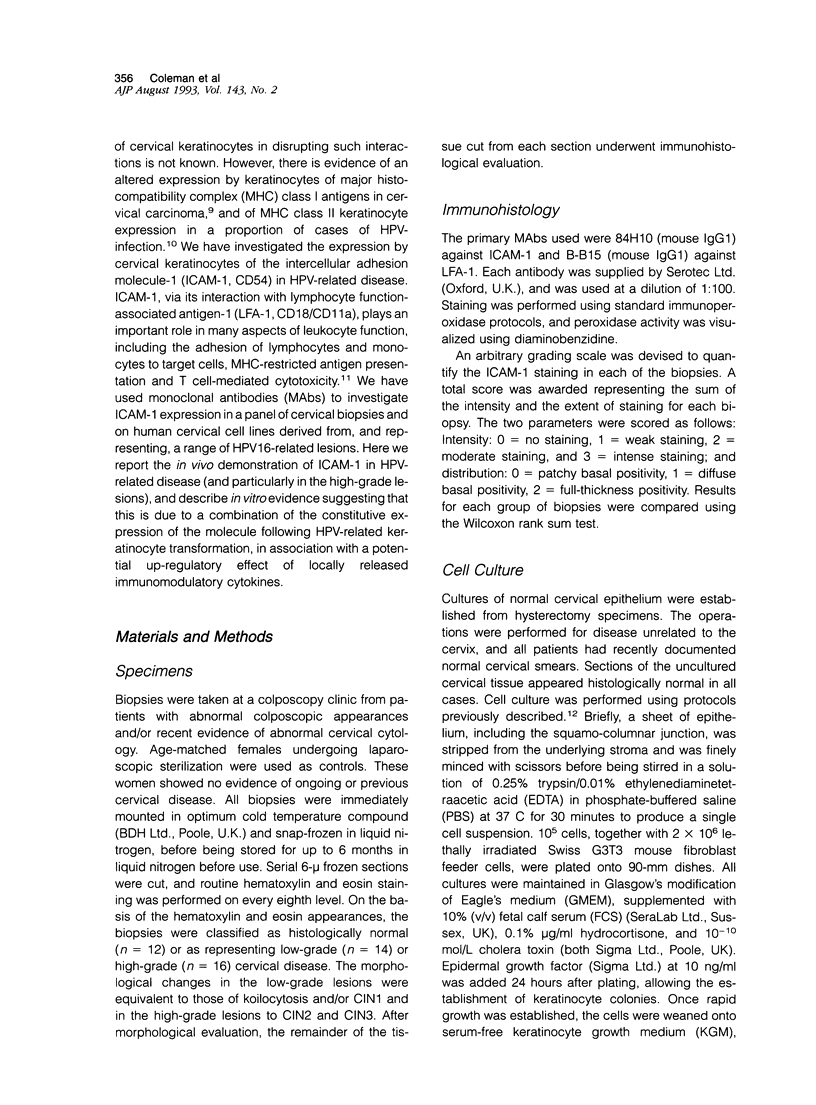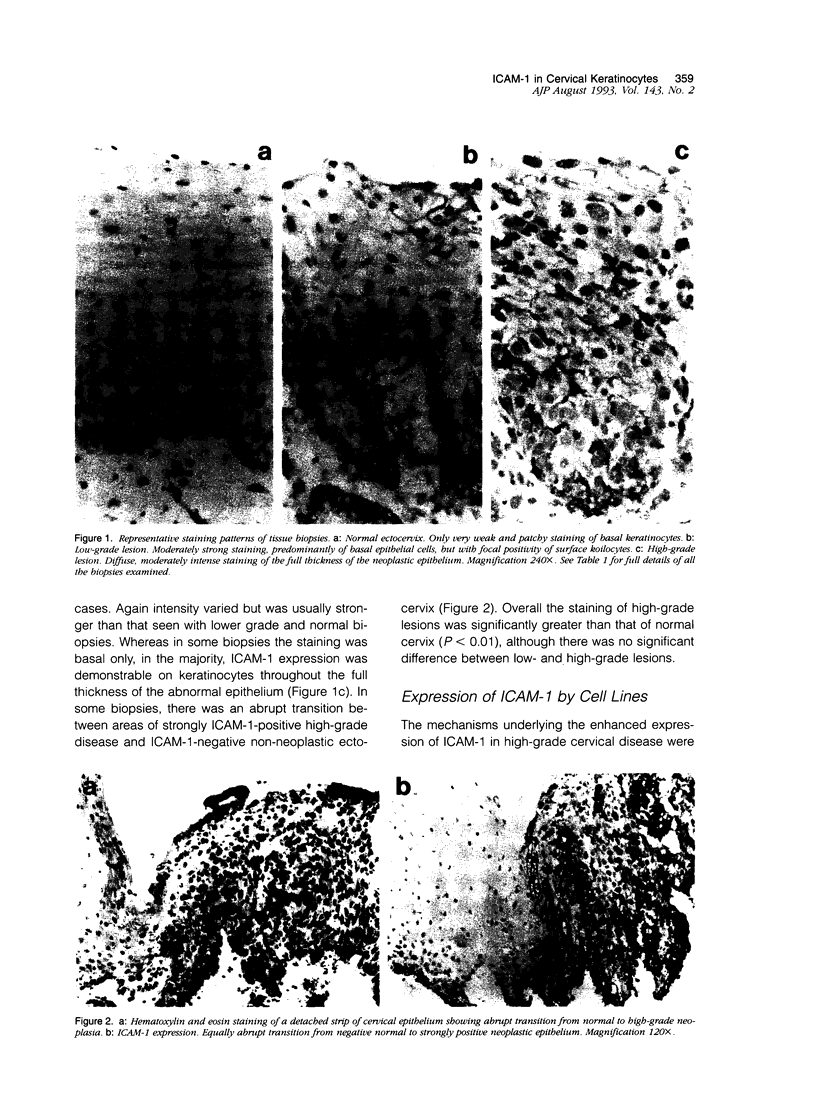Abstract
We have investigated the expression of intercellular adhesion molecule-1 (ICAM-1) in squamous neoplasia of the cervix and have noted a significant induction of the molecule in high-grade intra-epithelial lesions. Using monolayer and organotypic in vitro tissue culture systems, we have shown that there is no constitutive ICAM-1 expression on cervical keratinocytes immortalized but not transformed by human papillomavirus type 16, whereas two human papillomaviruses type 16 containing and fully transformed cervical keratinocyte lines do constitutively express the molecule. All cell types, including human papillomavirus-negative normal cervical keratinocytes, can be induced to up-regulate their expression of ICAM-1 by pro-inflammatory cytokines such as interferon-gamma. In addition, we have used an in vitro adhesion assay to show that ICAM-1:lymphocyte function antigen-1 interaction is functionally important in lymphocyte binding to cervical keratinocytes, suggesting a role for ICAM-1 in retaining and enabling functional activity of lymphocytes in the cervix in intraepithelial neoplasia.
Full text
PDF












Images in this article
Selected References
These references are in PubMed. This may not be the complete list of references from this article.
- Altmann D. M., Hogg N., Trowsdale J., Wilkinson D. Cotransfection of ICAM-1 and HLA-DR reconstitutes human antigen-presenting cell function in mouse L cells. Nature. 1989 Apr 6;338(6215):512–514. doi: 10.1038/338512a0. [DOI] [PubMed] [Google Scholar]
- Billaud M., Calender A., Seigneurin J. M., Lenoir G. M. LFA-1, LFA-3, and ICAM-1 expression in Burkitt's lymphoma. Lancet. 1987 Dec 5;2(8571):1327–1328. doi: 10.1016/s0140-6736(87)91214-1. [DOI] [PubMed] [Google Scholar]
- Campana D., Sheridan B., Tidman N., Hoffbrand A. V., Janossy G. Human leukocyte function-associated antigens on lympho-hemopoietic precursor cells. Eur J Immunol. 1986 May;16(5):537–542. doi: 10.1002/eji.1830160513. [DOI] [PubMed] [Google Scholar]
- Campbell I. L., Cutri A., Wilkinson D., Boyd A. W., Harrison L. C. Intercellular adhesion molecule 1 is induced on isolated endocrine islet cells by cytokines but not by reovirus infection. Proc Natl Acad Sci U S A. 1989 Jun;86(11):4282–4286. doi: 10.1073/pnas.86.11.4282. [DOI] [PMC free article] [PubMed] [Google Scholar]
- Connor M. E., Stern P. L. Loss of MHC class-I expression in cervical carcinomas. Int J Cancer. 1990 Dec 15;46(6):1029–1034. doi: 10.1002/ijc.2910460614. [DOI] [PubMed] [Google Scholar]
- Cunningham A. L., Noble J. R. Role of keratinocytes in human recurrent herpetic lesions. Ability to present herpes simplex virus antigen and act as targets for T lymphocyte cytotoxicity in vitro. J Clin Invest. 1989 Feb;83(2):490–496. doi: 10.1172/JCI113908. [DOI] [PMC free article] [PubMed] [Google Scholar]
- Dougherty G. J., Murdoch S., Hogg N. The function of human intercellular adhesion molecule-1 (ICAM-1) in the generation of an immune response. Eur J Immunol. 1988 Jan;18(1):35–39. doi: 10.1002/eji.1830180107. [DOI] [PubMed] [Google Scholar]
- Dustin M. L., Rothlein R., Bhan A. K., Dinarello C. A., Springer T. A. Induction by IL 1 and interferon-gamma: tissue distribution, biochemistry, and function of a natural adherence molecule (ICAM-1). J Immunol. 1986 Jul 1;137(1):245–254. [PubMed] [Google Scholar]
- Dustin M. L., Singer K. H., Tuck D. T., Springer T. A. Adhesion of T lymphoblasts to epidermal keratinocytes is regulated by interferon gamma and is mediated by intercellular adhesion molecule 1 (ICAM-1). J Exp Med. 1988 Apr 1;167(4):1323–1340. doi: 10.1084/jem.167.4.1323. [DOI] [PMC free article] [PubMed] [Google Scholar]
- Fais S., Delle Fratte F., Mancini F., Cioni V., Guadagno M., Vetrano G., Pallone F. Human cervical epithelial cells that express HLA-DR associated with viral infection and activated mononuclear cell infiltrate. J Clin Pathol. 1991 Apr;44(4):290–292. doi: 10.1136/jcp.44.4.290. [DOI] [PMC free article] [PubMed] [Google Scholar]
- Friedl F., Kimura I., Osato T., Ito Y. Studies on a new human cell line (SiHa) derived from carcinoma of uterus. I. Its establishment and morphology. Proc Soc Exp Biol Med. 1970 Nov;135(2):543–545. doi: 10.3181/00379727-135-35091a. [DOI] [PubMed] [Google Scholar]
- Gaspari A. A., Jenkins M. K., Katz S. I. Class II MHC-bearing keratinocytes induce antigen-specific unresponsiveness in hapten-specific Th1 clones. J Immunol. 1988 Oct 1;141(7):2216–2220. [PubMed] [Google Scholar]
- Gregory C. D., Murray R. J., Edwards C. F., Rickinson A. B. Downregulation of cell adhesion molecules LFA-3 and ICAM-1 in Epstein-Barr virus-positive Burkitt's lymphoma underlies tumor cell escape from virus-specific T cell surveillance. J Exp Med. 1988 Jun 1;167(6):1811–1824. doi: 10.1084/jem.167.6.1811. [DOI] [PMC free article] [PubMed] [Google Scholar]
- Griffiths C. E., Esmann J., Fisher G. J., Voorhees J. J., Nickoloff B. J. Differential modulation of keratinocyte intercellular adhesion molecule-I expression by gamma interferon and phorbol ester: evidence for involvement of protein kinase C signal transduction. Br J Dermatol. 1990 Mar;122(3):333–342. doi: 10.1111/j.1365-2133.1990.tb08281.x. [DOI] [PubMed] [Google Scholar]
- Johnson J. P., Stade B. G., Holzmann B., Schwäble W., Riethmüller G. De novo expression of intercellular-adhesion molecule 1 in melanoma correlates with increased risk of metastasis. Proc Natl Acad Sci U S A. 1989 Jan;86(2):641–644. doi: 10.1073/pnas.86.2.641. [DOI] [PMC free article] [PubMed] [Google Scholar]
- Leon J. A., Mesa-Tejada R., Gutierrez M. C., Estabrook A., Greiner J. W., Schlom J., Fisher P. B. Increased surface expression and shedding of tumor associated antigens by human breast carcinoma cells treated with recombinant human interferons or phorbol ester tumor promoters. Anticancer Res. 1989 Nov-Dec;9(6):1639–1647. [PubMed] [Google Scholar]
- Makgoba M. W., Sanders M. E., Ginther Luce G. E., Gugel E. A., Dustin M. L., Springer T. A., Shaw S. Functional evidence that intercellular adhesion molecule-1 (ICAM-1) is a ligand for LFA-1-dependent adhesion in T cell-mediated cytotoxicity. Eur J Immunol. 1988 Apr;18(4):637–640. doi: 10.1002/eji.1830180423. [DOI] [PubMed] [Google Scholar]
- McKenzie J., King A., Hare J., Fulford T., Wilson B., Stanley M. Immunocytochemical characterization of large granular lymphocytes in normal cervix and HPV associated disease. J Pathol. 1991 Sep;165(1):75–80. doi: 10.1002/path.1711650112. [DOI] [PubMed] [Google Scholar]
- Nickoloff B. J., Lewinsohn D. M., Butcher E. C. Enhanced binding of peripheral blood mononuclear leukocytes to gamma-interferon-treated cultured keratinocytes. Am J Dermatopathol. 1987 Oct;9(5):413–418. doi: 10.1097/00000372-198710000-00007. [DOI] [PubMed] [Google Scholar]
- Nickoloff B. J., Mitra R. S., Shimizu Y., Barker J. N., Karabin G., Stoof T., Stoolman L. M. HUT 78 T cells bind to noncytokine-stimulated keratinocytes using a non-CD18-dependent adhesion pathway. Am J Pathol. 1992 Jun;140(6):1365–1374. [PMC free article] [PubMed] [Google Scholar]
- Nickoloff B. J., Reusch M. K., Bensch K., Karasek M. A. Preferential binding of monocytes and Leu 2+ T lymphocytes to interferon-gamma treated cultured skin endothelial cells and keratinocytes. Arch Dermatol Res. 1988;280(4):235–245. doi: 10.1007/BF00513963. [DOI] [PubMed] [Google Scholar]
- Pattillo R. A., Hussa R. O., Story M. T., Ruckert A. C., Shalaby M. R., Mattingly R. F. Tumor antigen and human chorionic gonadotropin in CaSki cells: a new epidermoid cervical cancer cell line. Science. 1977 Jun 24;196(4297):1456–1458. doi: 10.1126/science.867042. [DOI] [PubMed] [Google Scholar]
- Porreco R., Penn I., Droegemueller W., Greer B., Makowski E. Gynecologic malignancies in immunosuppressed organ homograft recipients. Obstet Gynecol. 1975 Apr;45(4):359–364. [PubMed] [Google Scholar]
- Rothlein R., Czajkowski M., O'Neill M. M., Marlin S. D., Mainolfi E., Merluzzi V. J. Induction of intercellular adhesion molecule 1 on primary and continuous cell lines by pro-inflammatory cytokines. Regulation by pharmacologic agents and neutralizing antibodies. J Immunol. 1988 Sep 1;141(5):1665–1669. [PubMed] [Google Scholar]
- Shaw S., Luce G. E., Quinones R., Gress R. E., Springer T. A., Sanders M. E. Two antigen-independent adhesion pathways used by human cytotoxic T-cell clones. Nature. 1986 Sep 18;323(6085):262–264. doi: 10.1038/323262a0. [DOI] [PubMed] [Google Scholar]
- Springer T. A. Adhesion receptors of the immune system. Nature. 1990 Aug 2;346(6283):425–434. doi: 10.1038/346425a0. [DOI] [PubMed] [Google Scholar]
- Stanley M. A., Browne H. M., Appleby M., Minson A. C. Properties of a non-tumorigenic human cervical keratinocyte cell line. Int J Cancer. 1989 Apr 15;43(4):672–676. doi: 10.1002/ijc.2910430422. [DOI] [PubMed] [Google Scholar]
- Stauder R., Greil R., Schulz T. F., Thaler J., Gattringer C., Radaskiewicz T., Dierich M. P., Huber H. Expression of leucocyte function-associated antigen-1 and 7F7-antigen, an adhesion molecule related to intercellular adhesion molecule-1 (ICAM-1) in non-Hodgkin lymphomas and leukaemias: possible influence on growth pattern and leukaemic behaviour. Clin Exp Immunol. 1989 Aug;77(2):234–238. [PMC free article] [PubMed] [Google Scholar]
- Tay S. K., Jenkins D., Maddox P., Campion M., Singer A. Subpopulations of Langerhans' cells in cervical neoplasia. Br J Obstet Gynaecol. 1987 Jan;94(1):10–15. doi: 10.1111/j.1471-0528.1987.tb02244.x. [DOI] [PubMed] [Google Scholar]
- Tay S. K., Jenkins D., Maddox P., Hogg N., Singer A. Tissue macrophage response in human papillomavirus infection and cervical intraepithelial neoplasia. Br J Obstet Gynaecol. 1987 Nov;94(11):1094–1097. doi: 10.1111/j.1471-0528.1987.tb02296.x. [DOI] [PubMed] [Google Scholar]
- Tay S. K., Jenkins D., Maddox P., Singer A. Lymphocyte phenotypes in cervical intraepithelial neoplasia and human papillomavirus infection. Br J Obstet Gynaecol. 1987 Jan;94(1):16–21. doi: 10.1111/j.1471-0528.1987.tb02245.x. [DOI] [PubMed] [Google Scholar]
- Tomita Y., Nishiyama T., Watanabe H., Fujiwara M., Sato S. Expression of intercellular adhesion molecule-1 (ICAM-1) on renal-cell cancer: possible significance in host immune responses. Int J Cancer. 1990 Dec 15;46(6):1001–1006. doi: 10.1002/ijc.2910460609. [DOI] [PubMed] [Google Scholar]
- Viac J., Guérin-Reverchon I., Chardonnet Y., Brémond A. Langerhans cells and epithelial cell modifications in cervical intraepithelial neoplasia: correlation with human papillomavirus infection. Immunobiology. 1990 Jun;180(4-5):328–338. doi: 10.1016/s0171-2985(11)80296-2. [DOI] [PubMed] [Google Scholar]
- Vogetseder W., Feichtinger H., Schulz T. F., Schwaeble W., Tabaczewski P., Mitterer M., Böck G., Marth C., Dapunt O., Mikuz G. Expression of 7F7-antigen, a human adhesion molecule identical to intercellular adhesion molecule-1 (ICAM-1) in human carcinomas and their stromal fibroblasts. Int J Cancer. 1989 May 15;43(5):768–773. doi: 10.1002/ijc.2910430504. [DOI] [PubMed] [Google Scholar]
- Vose B. M., Moore M. Human tumor-infiltrating lymphocytes: a marker of host response. Semin Hematol. 1985 Jan;22(1):27–40. [PubMed] [Google Scholar]
- zur Hausen H. Human papillomaviruses in the pathogenesis of anogenital cancer. Virology. 1991 Sep;184(1):9–13. doi: 10.1016/0042-6822(91)90816-t. [DOI] [PubMed] [Google Scholar]






